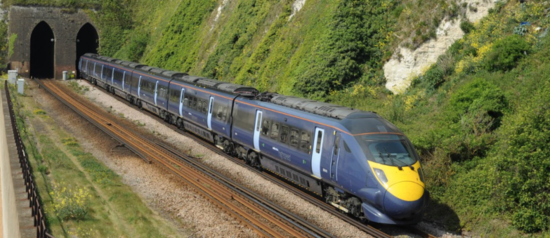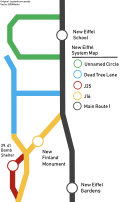Portal:Transportation

| Home | Category | Images |
|---|---|---|
| Introduction | ||
| Transport (or transportation) is the movement of people, animals and produce from one location to another (commonly referred to as "Point A to point B"). Forms of transportation include air, land (rail and road), water, cable, pipeline and space. The field can be divided into infrastructure, vehicles and operations. Transport enables trade between people, which is essential for the development of civilizations and societies.
Transport infrastructure consists of fixed installations, such as roads, railways, airways, aqueducts, canals and pipelines and terminals such as airports, railway stations, bus stations, warehouses, trucking terminals, refueling depots (including fueling docks and fuel stations) and seaports. Terminals may be used both for interchange of passengers and cargo and for maintenance. In the Micronational world, transportation usually involves scale models of railway rolling stock or aircraft, as most Nations cannot afford for 1:1 vehicles and the associated infastructure alongside it. Roads are usually operated with ride-on vehicles such as bicycles, scooters, ect. These are usually run over pavements or walkways classified as "Roads" or in some cases, "Motorways". | ||
| Today's article | S | |
|
New Eiffel Main Route 1 (NEMR 1), or simply the Main Route or Main Route 1 is a 42.8-metre (140 ft) long state highway which travels from Plitvice to Új Repülő. The highway has existed since at least January 2018 and was designated as New Eiffel Road 1 until it was renamed on February 2018. It is the longest and most traveled on road in New Eiffel, and the only fully paved one. It was one of the first two roads constructed/named in New Eiffel, alongside the J16. The road begins at the eastern most point in Plitvice at the border between the city of New Leeds in Seat Street and ends at the New Eiffel-United Kingdom West Border in Új Repülő. It runs alongside New Eiffel Gardens, before it leads into Új Repülő and intersects with Prince Zabëlle I Road, then turns to the south after about 26.6 m (87.3 ft), before turning back to the west. |
The royal coat of arms of the Baustralia, or the Royal Arms for short, is the official coat of arms of the Baustralian monarch, John. These arms are used by the King as the monarch of the Baustralia. Variants of the Royal Arms are used by other members of the Baustralian royal family. The arms in banner form serve as basis for the monarch's official flag, known as the Royal Standard. In the standard variant used outside of Scotland, the shield is quartered, depicting in the first and fourth quarters the Baustralian fish; in the second, the Riel of Ostreum; and in the third, a W for Wangatangia. The crest is a statant guardant lion wearing the Tudor, himself on another representation of that crown. The supporters are a likewise crowned lion. In the greenery below, a fish swimming in a creek are depicted, representing Tentacion Creek, which was the location of the battle for Tentacion independence. This armorial achievement comprises the motto, in French, of the Baustralian monarch, Dieu et mon Droit (God and my Right), as well as the Gadus circlet which surrounds the shield, inscribed with the Order's motto, A bene placito (From one well pleased).
| |

